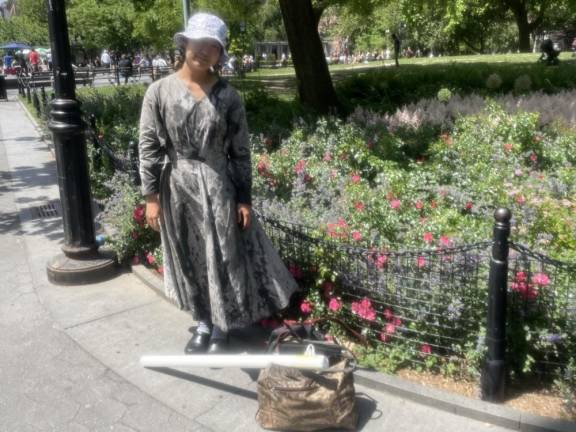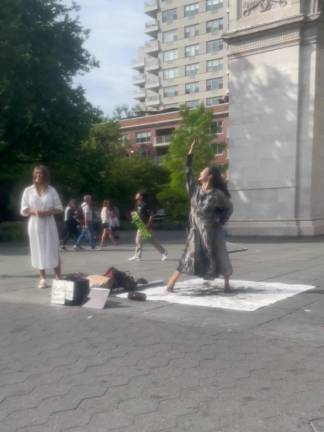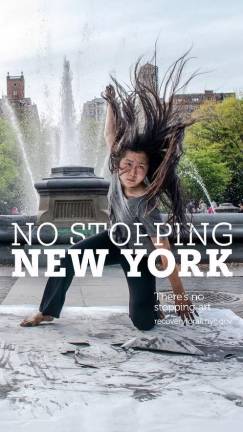‘Let Hair Down’
In Washington Square, Kanami Kusajima blurs the lines between dance and art
Kanami Kusajima wears an ink-stained dress and bucket hat, carrying a bag with a Winnie the Pooh design that has heavily faded away. Kusajima, a petite, long-haired young dancer with a strong presence, is a street performer, a common sight in New York City. However, what makes her unique is that she manages to merge the two most common forms of street performance, dance and art, into one impressive spectacle.
Known on social media as “Let Hair Down,” Kusajima came to America from Japan to study dance in college. She started her post-graduate life in 2020, the very start of the pandemic. She struggled to find a place to demonstrate her skills as all the theaters and galleries were closed. One day, she came across an artist in Washington Square Park named “Pinokio” who specialized in painting with black ink.
The two decided to collaborate: Pinokio painted elaborate pieces while Kusajima danced on a paper canvas. This encounter inspired Kusajima’s signature paint-and-dance performance. Her social media name stems from how she kept her hair down during her shows with Pinokio, always long enough to obscure her face. “I thought it was one of the ways to match the aesthetic with what he was doing,” said Kusajima. Now performing on her own, the name took a new meaning as she later discovered the phrase to be an idiom synonymous with being relaxed and taking things easy.
With her hands and bare feet drenched in ink, she spins and contorts on a white paper mat as the day goes on in Washington Square Park. Her art is one of a kind: a white mat with black streaks and splotches. Every piece is dated and signed. Currently, she keeps most of her art stored at home, but has received requests from eager fans to buy her paintings. “I’ve shipped my painting works to Vienna, Seattle, and London,” she said. “It’s just really interesting to see how it’s becoming international.” As her social media presence expands, some out-of-state fans make an effort to visit Washington Square Park to see her dance.
Black Ink
For an artist, every detail counts, which is why Kusajima specifically uses Sumi Ink, a type of ink made from soot, and often used in calligraphy. “People were using this [sumi ink] to keep a record of history from thousands of years ago ... so I feel something powerful in it.” While she prefers to use black ink, she also enjoys experimenting with other colors, such as blue and yellow to show solidarity with Ukraine. For her, knowing that once the ink is on the paper and can never be erased afterward adds an element of decisiveness that comes together with her improvisational approach to dance.
Kusajima enjoys dancing to music from her portable speaker. She twirls and raises her arms like a ballerina while dancing to classical music. Occasionally, she allows her audience to submit songs to accompany her performance. Always positioned in front of the signature Washington Square Arch, her dance is rarely a solo act.
With her journey as a performer originating through collaboration, Kusajima now returns the favor by working with other artists. One is Osaka Vagabond, a local guitarist who similarly to Kusajima, struggled to find venues to perform during the pandemic and ended up performing on the street. Vagabond hosts a monthly open mic event called “Yosemic” during which Kusajima often co-hosts.
“We try to bring artists and performers we met on the street because we believe when creative people connect to each other in the community, it makes people feel safer in public spaces,” said Vagabond. Another collaborator, Johan Figueroa Gonzalez, a “living statue” performer who frequents Washington Square Park, says, “It’s extremely important for artists and street performers to create a kind of supportive web.”
“I Sing Anywhere”
When interviewing Kusajima in the park, she was joined by her friend, Manami Aoki, an operatic singer who goes by the name “I Sing Anywhere” on social media. Aoki had known Kusajima since college, after meeting in a jazz bar where Aoki showed off her singing. Just as her dance is always improvised, working together with other artists happens as a spur-of-the-moment decision for Kusajima. “Today, I was having a meeting, and then I just thought, ‘oh here’s Kanami, let me join in,’ so it’s a very easy thing,” said Aoki.
One of the challenges for Kusajima was transitioning from indoor to outdoor dancing. She quickly learned that performing on solid concrete is much more painful than on a mat. Another downside is that being an independent dancer also brings uncertainty to her financial situation. “No one is taking care of you, which makes me fully responsible for myself” said Kusajima.
The changing seasons also prove difficult for her. She regularly changes her diet to take in more calories in the winter or drinks a lot more water and Gatorade in the summer. Despite these tribulations, Kusajima knows when to humble herself and take a break. “If I push myself way too hard for the entire month ... then if I cannot dance for the next two or three months – that’s something I really want to avoid.”
When asked what her two-year career as a street performer brought her the most joy, Kusajima said it was being featured as an advertisement for the city’s reopening campaign. The ad: a striking still of her dancing, her hair spread in the air, with the words “NO STOPPING NEW YORK” in the foreground. “I was happy to see people who are feeling happy about seeing those images around the city because that’s my goal for each performance,” she said.
With plans to briefly visit Japan soon, Kusajima considers bringing her performance to the streets of her home country. “I think people [in Japan] are not used to the New York type of street performers,” she said. ”I’m hoping some people find something enjoyable or interesting in my performance.” Even with her eyes currently set on Japan, it won’t be long before Washington Square Park finds itself complete again with Kusajima’s mesmerizing dance in front of its iconic arch.


